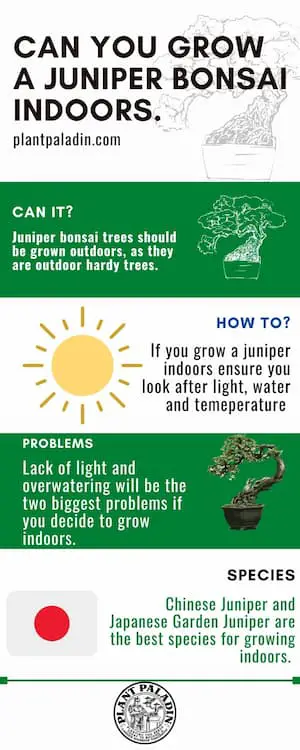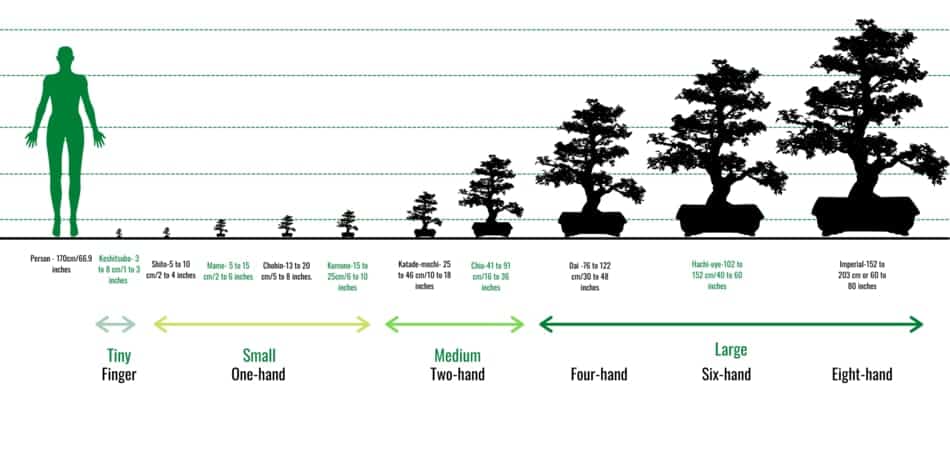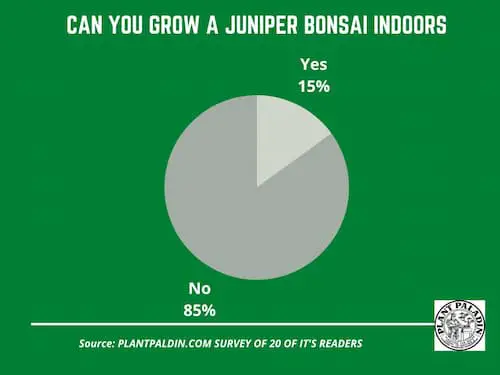This website is supported by its readers. If you click one of my links I may earn a commission. I am also a participant in the Amazon affiliates program and I will also earn a commission from qualified purchases.

One of the most popular bonsai species globally must be the humble juniper tree. With their thin needle-like leaves and easygoing nature, these bonsai are typically amongst the first outdoor bonsai trees many of us (myself included) own. I’ve always wondered, then, can you grow juniper bonsai indoors?
Juniper bonsai trees should not be grown indoors but kept outdoors. These trees can be grown indoors under specific conditions; however, you must pay attention to light, temperature, soil, and humidity to grow a healthy juniper bonsai.
So what juniper bonsai species will work best if you grow a juniper indoors? And what are the benefits and drawbacks of growing a juniper bonsai tree indoors?
Keep reading to find out more!
Just a quick heads up, over the past three years of running Plantpaladin, hundreds of people have asked for product recommendations. As such, You can find my favorite indoor bonsai tree here (link takes you to Bonsaiboy), my favorite outdoor bonsai tree (link takes you to Bonsaiboy), or have a look at all the products I recommend here.
Can you grow a juniper bonsai indoors?
To determine whether you can grow a juniper bonsai indoors, I surveyed 20 plant paladin readers who own junipers, asking them this very question. I also contacted a few bonsai experts and even visited my local botanical gardens to get to the bottom of this. All to ensure you have the most up-to-date post on the topic. To summarize:
- Generally, Juniper bonsai trees should not be grown indoors; these are hardy outdoor evergreen trees.
- As such, they will be at their healthiest in cooler temperatures – typically between 10 to 85 degrees Fahrenheit.
- As such, in most climates, Juniper bonsai trees can be kept outdoors even during pretty cold winters.
- That said, if you adjust your indoor climate, ensuring it does not get too warm and you manage the sunlight, juniper bonsai trees can be grown successfully indoors.
- This will likely require much more patience and work to grow Juniper indoors successfully.
- People will grow their juniper bonsai indoors for aesthetic reasons (i.e., they like how the tree looks) or because they are tight on space and need a backyard/garden to grow these trees in.
- The best juniper bonsai trees more adaptable to growing indoors include Japanese garden juniper, Chinese Juniper, and Savin juniper.

Now this is a lot of information, so let’s go into more detail on some of the points above.
How to grow Juniper bonsai indoors
So now we know that juniper bonsai prefer the outdoors to indoors, you might think all is lost!
Fret not, however, as while it is more challenging to grow juniper bonsai indoors, you can still achieve it!
To successfully grow juniper bonsai trees indoors, you must mimic the outdoor conditions Juniper needs to thrive indoors.
This breaks down into the following key areas:
- Sunlight
- Watering
- Pest & Diseases
- Temperature
- Humidity
- Fertilizing
- Soil
- Training.
While I’ve gone in-depth into each of these in my post about caring for a juniper tree here, let’s break down these care detain specifically for keeping Junipers indoors.
Sunlight
So growing a juniper indoors can be challenging due to its light needs.
Juniper bonsai trees, regardless of sub-species, need around 4 hours of direct sunlight per day to maintain themselves.
Filtered sunlight through a window is not enough to maintain your tree, so using artificial grow light is your best bet to ensure the tree gets enough light.
Aim to use a grow light that has the entire light spectrum.
Watering
You can overwater Juniper very easily.
As such, you must only water when the topsoil is dry.
Typically when kept outdoors, you might only water once per week, but when kept indoors, when the water goes dry as quickly, consider watering slightly less frequently, such as once every ten days.
Pests and diseases
One of the main benefits of keeping your Juniper indoors is that it is less likely to get attacked by aphids, whiteflies, spider mites, and other common insects that will attack your tree outdoors.
That said, overwatering is commonplace, so ensure you keep an eye out for fungal infections and use fungicides to treat them.
Temperature
One of the significant challenges of growing a juniper bonsai tree indoors will be managing the right temperature.
Juniper bonsai grow best between 10 and 85 degrees F.
In the summer, indoors can exceed these temperatures dramatically, so try to keep your juniper tree in a space where the temperature stays the same year-round.
Humidity
Juniper bonsai trees prefer cooler environments, so keeping your Juniper in a greenhouse or other humid space won’t work.
As mentioned, these trees are very susceptible to overwatering, and if you leave these trees in a humid space for too long, root rot and other fungal conditions will soon develop.
Fertilizing
Using fertilizer on your Juniper can remain the same indoors as you would use it outdoors.
Use an active liquid fertilizer with a balanced N-P-K ratio once monthly during the spring and summer.
Avoid using it during the fall and winter months.
Soil
The most significant difference between juniper bonsai and traditional indoor bonsai trees such as chinese elms or Ficus will be the type of soil you use.
For Juniper, I would stick to using a natural outdoor soil mix.
For best results, I would typically mix 30% peat moss soil with 70% inorganic material such as akadama, volcanic ash rock, or pumice.
Training
So wiring, training, repotting, and pruning your juniper bonsai tree will all be undertaken in the same way indoors and outdoors.
Aim then to repot every 3 to 5 years, train the trunk after five years, and wire only during the spring and summer.
Why does juniper bonsai prefer the outdoors instead of indoors?
Juniper bonsai, like most other bonsai trees, generally prefer outdoor conditions rather than being kept indoors for several reasons:
Light Requirements:
Juniper bonsai trees require a significant amount of direct sunlight to thrive. Providing the same intensity and duration of sunlight as they would receive outdoors can be challenging. Insufficient light can lead to weak growth, long branches, and poor overall health.
Temperature and Humidity:
Juniper bonsai trees are adapted to outdoor climates and appreciate the natural fluctuations in temperature and humidity. Indoor environments tend to have more stable and controlled conditions, which may only partially mimic the natural seasonal changes that junipers need for their growth cycles.
Air Circulation:
Good air circulation is vital for the health of juniper bonsai trees. It helps prevent the development of fungal diseases and encourages proper transpiration. Indoors, air circulation is typically limited compared to the outdoors, leading to stagnant air and potential problems.
Growth and Size:
Juniper bonsai trees are typically vigorous growers and can become significant over time. Indoors, space constraints can restrict their growth potential and prevent them from reaching their full size and natural beauty.
What juniper species work best for growing indoors
Japanese Garden Juniper, Chinese Juniper, Flakey Juniper, Temple Juniper, and Savin Juniper can all be adapted to grow indoors. All these trees will be at their healthiest when grown outdoors.
The following species, then, tend to perform the best indoors for the following reasons:
- Juniperus procumbens (Japanese Garden Juniper): This species is a popular choice for bonsai, known for its beautiful, trailing branches and compact growth habit. It is tolerant of indoor conditions and responds well to pruning and shaping.
- Juniperus chinensis (Chinese Juniper): Chinese Juniper is another commonly used species for bonsai, offering a wide range of varieties. It has excellent adaptability to indoor environments and can be trained in various bonsai styles.
- Juniperus squamata (Flaky Juniper): Flaky Juniper is a hardy species that can thrive indoors. It has attractive foliage with blue-green coloration and a rugged appearance, making it a popular choice for bonsai enthusiasts.
- Juniperus rigida (Temple Juniper): Temple Juniper is a species native to Japan and is well-suited for indoor bonsai cultivation. It has a compact growth habit and needle-like foliage, giving it an elegant and refined look.
- Juniperus sabina (Savin Juniper): Savin Juniper is a small, slow-growing species that adapts well to container cultivation. It has dense, dark green foliage and can be trained into various bonsai styles.
Why would you want to grow a juniper bonsai indoors?
People mainly opt to grow a juniper bonsai tree indoors due to the lack of space outdoors.
Juniper bonsai trees are trendy due to their beautiful aesthetics.
Sadly, however, not everyone can afford a home with a backyard space, so people will try to cultivate and grow these trees indoors.
Secondly, owning plants is a matter of personal preference.
So if you already have a bonsai tree collection growing indoors, it is more convenient to move a traditional outdoor bonsai tree, such as a juniper, into an indoor space with the rest of your trees.
How big should an indoor juniper bonsai tree be?
For best results when growing a juniper bonsai tree indoors, aim to keep your bonsai no more than 30cm tall. This will ensure that it only takes up a little room and can maintain good health in a limited indoor space.
Typically the larger a juniper bonsai gets, the more it will feel the lack of being planted outdoors.
As such, it will require more resources, sunlight, and a specific climate to thrive.
Keeping your Juniper smaller will give your tree the best chance of survival indoors.

Benefits of growing juniper bonsai indoors
So while the general advice is not to grow a juniper bonsai tree indoors, there are some unorthodox benefits.
These include:
Accessibility and Convenience:
Growing juniper bonsai indoors lets you have a beautiful and captivating tree within your living space. You can enjoy its beauty, observe its growth, and tend to its care conveniently without needing to go outside.
Control over Environmental Factors:
Indoor cultivation gives you more control over light, temperature, and humidity. You can create a stable and consistent environment, ensuring the bonsai receives optimal conditions throughout the year.
Protection from Harsh Weather:
Keeping juniper bonsai indoors protects them from extreme weather conditions, such as frost, high winds, or intense heat. This can be particularly beneficial if you live in an area with challenging outdoor conditions.
Pest Management:
Indoor cultivation can provide some protection against common pests that may affect juniper bonsai. Keeping the tree indoors can minimize the risk of infestations from insects or diseases that may be more prevalent in outdoor environments.
Year-round Enjoyment:
Growing juniper bonsai indoors allows you to enjoy its beauty and presence year-round, regardless of the season. This can be particularly appealing if you live in a region with long winters or want a captivating indoor tree to admire throughout the year.
Problems with growing juniper bonsai indoors
As mentioned throughout this post, ideally, you want to grow juniper bonsai trees outdoors.
Growing a bonsai tree indoors will likely result in some of the following problems:
Insufficient Light
Juniper bonsai trees require a significant amount of direct sunlight to thrive. Indoors, providing the same intensity and duration of sunlight as they would receive outdoors can be challenging. Insufficient light can lead to weak growth, long branches, and poor overall health.
Inadequate Air Circulation
Indoor environments typically have limited air circulation compared to the outdoors. Poor air circulation can lead to stagnant air, increased risk of fungal diseases, and limited gas exchange, which can negatively impact the health of the juniper bonsai.
Limited Space for Growth
Juniper bonsai trees are naturally vigorous growers and can become extensive over time. Indoors, space constraints can restrict their growth potential and prevent them from reaching their full size and natural beauty.
Humidity and Overwatering
Indoor environments tend to have lower humidity levels than juniper bonsai trees’ natural habitat. It’s essential to balance providing sufficient humidity and avoiding excessive moisture, as overwatering can lead to root rot and other fungal issues.
Lack of Natural Seasonal Changes
Like many other plants, Juniper bonsai trees rely on natural seasonal changes to trigger growth cycles and maintain overall health. Replicating these natural cycles can be challenging indoors, where temperatures and lighting conditions remain relatively stable.
Pest Problems
Indoor cultivation does not guarantee immunity from pests. Juniper bonsai trees are susceptible to various pests, such as spider mites, scale insects, and aphids. Without proper care and vigilance, these pests can infest indoor bonsai trees and cause damage.
When should you move juniper bonsai indoors?
Juniper bonsai trees should be moved from outdoors to an indoor space if outdoor temperatures drop below 10 degrees Fahrenheit (-12 degrees Celsius) constantly for a few nights. Even the most hardy juniper bonsai trees will suffer at this temperature.
Is bonsai juniper outdoors or indoors?
Juniper bonsai trees are outdoor and should be kept outdoors throughout their lives. These trees should only be moved indoors in extreme temperatures or for training or pest control.
Can bonsai trees survive indoors?
Bonisa trees can survive indoors, with several species, such as Chinese elm, Ficus, and Jade, explicitly bred for indoor care. Indoor bonsai trees are typically much easier to care for and maintain than outdoor ones.
Survey results – can you grow juniper bonsai indoors:
Finally, I asked 20 plant paladin readers who own Juniper if they could grow juniper bonsai indoors.
Here are the results:

My top picks for the gear you will need!
So like I mentioned earlier, over the past three years of running PlantPaladin, hundreds of people have asked me for my recommendations on the best bonsai gear on the market.
Having spent thousands of dollars on bonsai items these past few years and tested at least 100 bonsai-specific products, I’ve listed my favorite products below – All of which I highly recommend and think you can get great value.
They can purchase directly by clicking the link to take them to Amazon.
Bonsai Tool Set: One of the significant challenges I’ve had is finding a toolset that was not only durable but didn’t break the bank. SOLIGT has recently developed a fantastic bonsai tool set that covers all the tools you need to trim, prune, and repot your trees. – You can grab it here.
Complete Bonsai Set: Many of you will want to grow your bonsai trees entirely from scratch, but finding the varicose seeds, pots, and other items in one place can be challenging. Leaves and Sole then have created a complete bonsai set that I’ve personally used that ticks all the boxes. You can grab it here.
Bonsai wire: The number of times I’ve run out of wire for my bonsai or purchased cheap bonsai wire that doesn’t do the job is embarrassing for me to admit. After a lot of trial and error, I found that using Hotop’s aluminum bonsai wire is one of the best options on the market. This can easily be used for both indoor and outdoor bonsai. You can grab it here.
